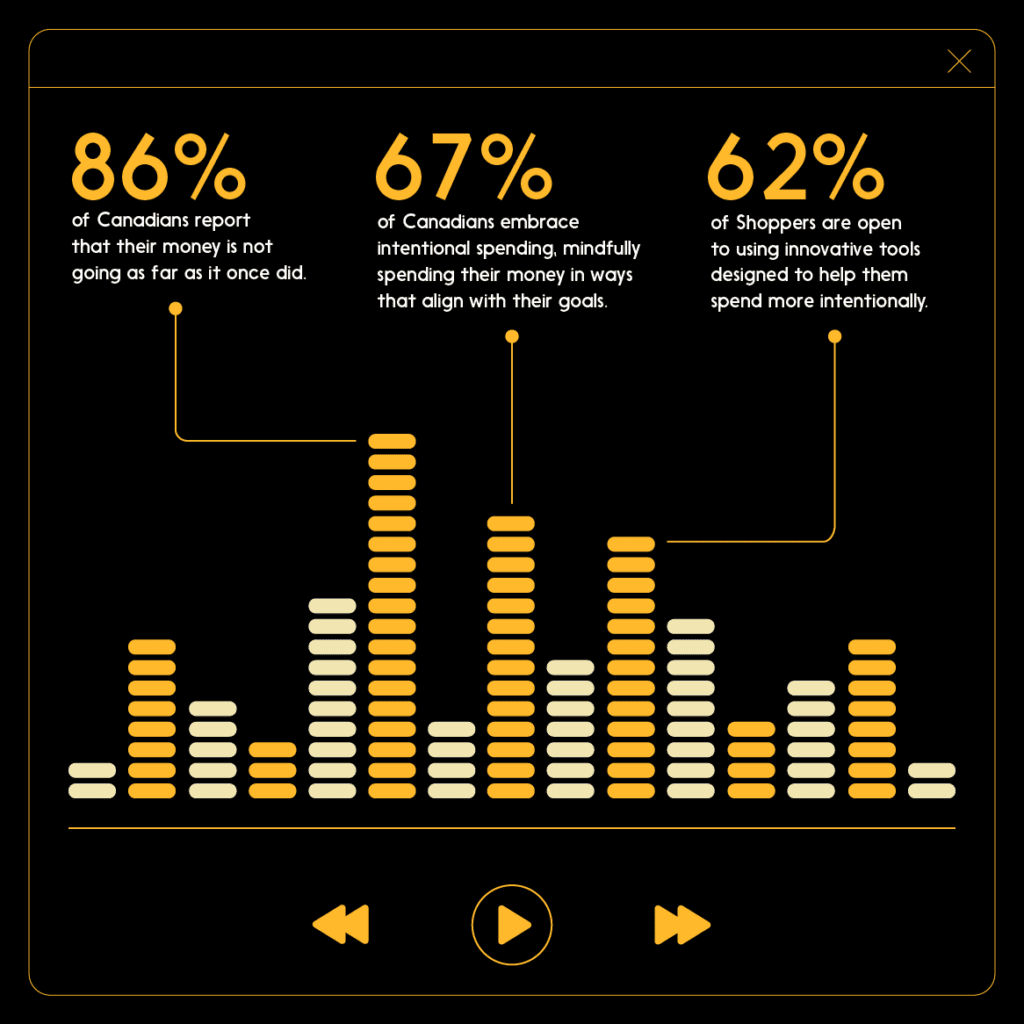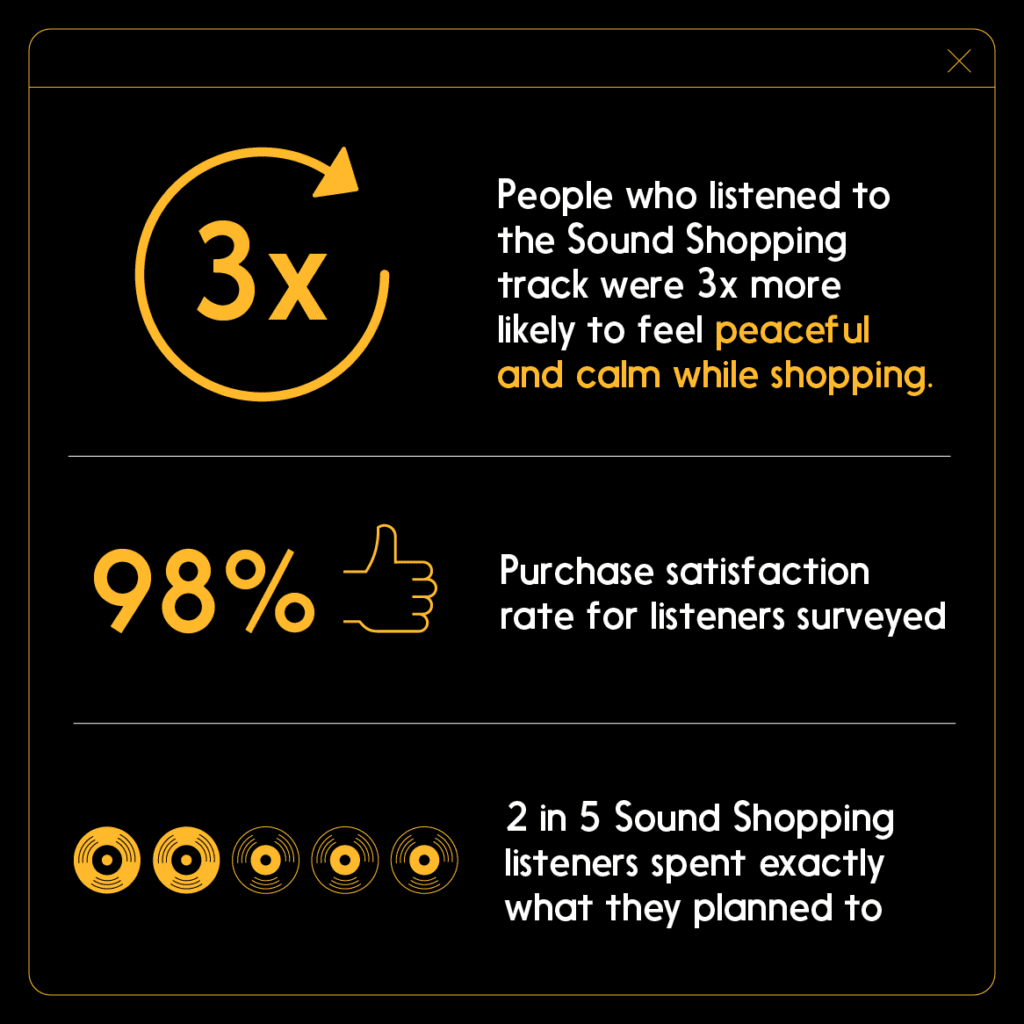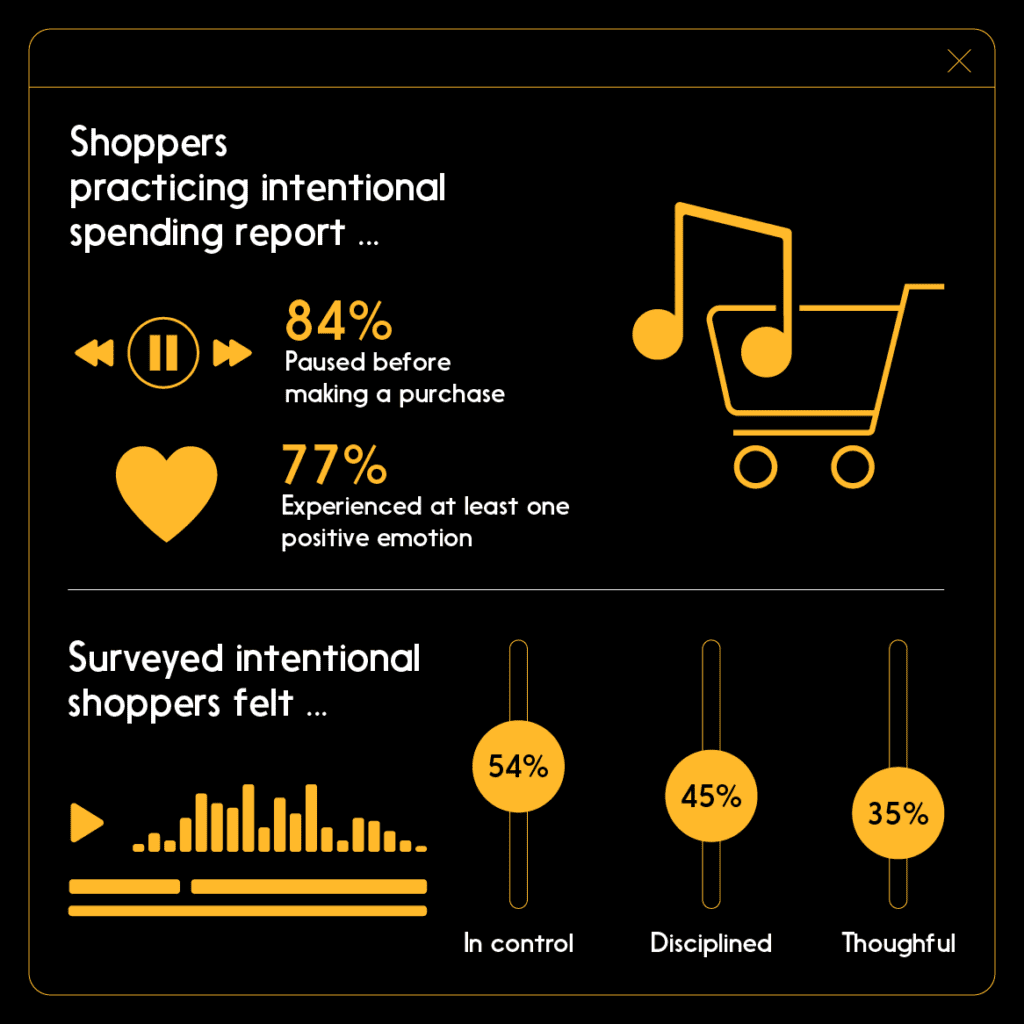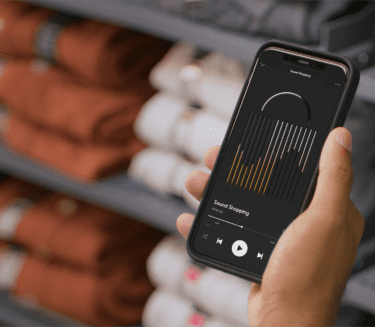When you think about how you spend money, music probably isn’t the first thing that comes to mind. Yet, with its endless variety of alluring tempos and sounds, music has the power to move us physically and emotionally. Research shows it can change how we shop, from how long we stay in a store or restaurant to how much we do or don’t buy—and even our overall satisfaction levels.
At Interac, we recently set out to explore the fascinating connection between music and spending. Our aim? To develop new, innovative tools rooted in the science of sound that can help people spend more mindfully, something more and more Canadians are doing.
Singing new tunes in new times
We know that in today’s constantly evolving economy, increasing numbers of Canadians are adjusting their spending, carefully budgeting and focusing on financial factors they can control. People are motivated to spend their money more intentionally on items and experiences that reflect and support their goals and values.
That’s because they’re feeling the pinch, with nearly nine in 10 Canadians (86 per cent) reporting that their money isn’t covering as much as it once did, according to research recently commissioned by Interac. Two-thirds (67 per cent) of Canadians embrace intentional spending, making purposeful purchases that align with their needs and aspirations.
Meanwhile, Interac data shows transaction volumes are increasing along with prices. As prices surge, six in 10 shoppers (62 per cent) express openness to tools that could help them spend more intentionally. More and more Canadians know the struggle to balance prioritizing saving with the desire to have fun is real, and they’re open to creative solutions. And what’s more creative than music?

Experimenting with song
With music on our minds, we ventured into melodious new territory. We commissioned a first-of-its-kind Sound Shopping music track to support the 67 per cent of Canadians seeking to spend more mindfully.
“Knowing music has traditionally been used to fuel purchasing in retail, we wanted to experiment with the ways it can positively impact and add pleasure to the shopping experience,” said Matt Houghton, Director of Digital and Integrated Marketing at Interac.
The 12-minute tune, carefully composed by leading designers at the Toronto-based sonic branding agency Sixième Son, is composed to enhance listener mindfulness and focus.
With the track, we aimed to create a peaceful, balanced backdrop for the shopping experience. We also wanted to help promote mindful spending during these times of financial uncertainty.
Music is the language of emotion
Music is the soundtrack of our lives. Rooted in hearing the reassuring heartbeat of our mother in utero, it’s an emotional, sensory experience. Music of all kinds elicits a broad array of feelings depending on a variety of elements, from tempo to melody to instrumentation and beyond.
It’s not hard to think of a song that tugs at your heartstrings or an upbeat anthem that pumps you up. Film composers know the psychological pull of music all too well, using it to make us feel delighted, surprised, sad and even frightened during movies.
But how are our emotions—and even our actions—shaped by music, scientifically speaking? Simply put, as our brains react to a song beat, the music activates neurons in our brain to fire at a specific rate, influencing how we feel and, often, setting our mood. For example, calming music has even been shown to lower levels of cortisol, a hormone that can contribute to feelings of anxiety and stress.
Tempo and mode set the ($pending) mood
Of course, the power of music rings out far beyond the big and small screen. For example, research shows that music significantly influences people’s moods and behaviours even sometimes affecting how long they wait to purchase things and how much they do or don’t spend.
For example, fast-paced, heart-pumping music makes us move quickly through shopping experiences like we tend to do at fast food restaurants. When hurried along by the driving fast beats of pop songs, we often buy less and move on quickly. Conversely, with slower paced music, shoppers are more likely to experience the power of the pause. Instead of hurrying along, Interac data shows shoppers who slow down and pause while browsing experience higher levels of satisfaction.
In contrast, when we hear slower, more soothing music, such as laid-back lounge jazz or relaxing classical, we tend to slow down and linger, like, say, at an expensive restaurant.
“The idea with jazz is to help you feel like you can spend a long time in there,” Kip Pegley, Queen’s University ethnomusicologist and professor, told Interac. “That way, you’re more tempted to buy alcohol, the biggest markup item at expensive restaurants.”
The element of surprise
Because we know that different beats can set different emotions in motion, the team tasked with creating the Sound Shopping track paid particular attention to the tempo, pacing and energy of the tune.
The instrumental song—which features piano, drums, guitar, birds chirping and many more elements—falls in the mid-range category. It ranges between 80 to 100 beats per minute, with a harmonic progression primarily in the major mode. And that’s no accident. In fact, the song was explicitly designed to be nonlinear and randomized, top to bottom. As such, it wistfully sails through varying tempos and soundscapes in short, distinctly asymmetrical bursts.
“Every 20 to 30 seconds, we added elements of surprise, like birds in the background,” said Valentin Fleur, Sixième Son’s Head of Strategy. “The effect we wanted was for the listener to say, ‘This is new. This is different. I’m in the moment.’ That way, they’re not sleepwalking through store aisles and rushing while shopping. Instead, they’re fully present.”
The thinking, he said, is that the specially architected sound variability, even unpredictability, can help shoppers listening to it be more focused and alert—and more mindful of their spending choices.
Ultimately, the intention behind the music is to help listeners keep their spending on track and support them in buying only the things they value to get more out of life.
Tempo=more than a minor consideration
Fleur also said he and his team were careful to avoid composing the track in slow, downtempo minor mode. Why? Because minor mode is linked to triggering sadness, which can lead to spending more than you intended to.
“We didn’t want any minor mode with Sound Shopping because studies show people tend to buy more when minor mode music is playing. That’s when you want that dopamine release, like when a purchase has a feeling of ‘Oh, I feel better because I purchased something I craved.’ So we countered that effect with the use of major mode.”
The idea, he said, was to engage the listener calmly but not to a point where they become so relaxed that they lose sight of their spending goals and overspend. That’s also why the track, designed to be played during a shopping trip around 20 minutes long, is composed to almost sound like a new song every few seconds.
Pegley said that purposeful inconsistency and unfamiliarity help the Interac track achieve “middle arousal,” which he feels is a good thing when it comes to shopping.
“As soon as you settle into something with the Sound Shopping track, it changes,” said Pegley. “Whereas with music that you know, and with a pretty consistent beat, we tend to start becoming unconscious of what we’re doing, and then really shop.”
That’s why Sound Shopping has an inconsistent sound designed to keep shoppers engaged and focused.
“You’ve got a bit of piano jazz at the beginning, and you’ve got a bit of pop happening throughout, but then you’ve got this spa and some new age,” Pegley said. “All these things nested within Sound Shopping are all nice listening, but they don’t allow you to just keep going unconsciously.”
Music to shoppers’ ears

Once the Sound Shopping track was mixed, harmonized and finalized, it was time to test it out. That’s when, in an Interac first, 300 Canadians participated in a study to gauge the impact of our custom music on spending behaviors.
To give it a spin, half the participants listened to the Sound Shopping track while visiting a mall or retail store, and the other half listened to pop music from a Spotify playlist.
According to the feedback we collected, people who listened to the Sound Shopping track were three times more likely to feel peaceful and calm while shopping and experienced a 98 per cent purchase satisfaction rate. Plus, 64 per cent of shoppers practicing intentional spending report pausing before making a purchase, and two in five participants spent exactly what they intended.
We couldn’t be more delighted with the results. “[Our] Research validated our belief that Canadians were looking for support in maintaining the intentional spending behaviours that were established over the course of the pandemic,” said William Keliehor, Chief Commercial Officer at Interac.
Fleur echoed Keliehor’s sentiments. “We saw that people spent less with our Sound Shopping track,” Fleur said, “so we were very pleased with the results. It was mind-blowing.”
Put Sound Shopping to the test
Wherever you are on your financial journey, you can benefit from adopting mindful spending habits. Our research shows that 77 per cent of people who practice intentional spending report experiencing at least one positive emotion.
Additionally, we found that 54 per cent of intentional shoppers surveyed feel in control, 45 per cent feel disciplined, and 35 per cent feel thoughtful. Who doesn’t want to experience those feelings and spend smarter in these changing times?

Luckily, music can be a fun and engaging tool you can use to get into the right frame of mind to spend more thoughtfully.
Research shows that choosing the right music to listen to while you shop, like our new Sound Shopping track, can help you spend more intentionally and increase purchase satisfaction.
Why not try the track out for yourself on your next shopping trip? You can access it here. And, don’t forget to add the track to your own playlists. Good luck, and happy—and focused—listening!



